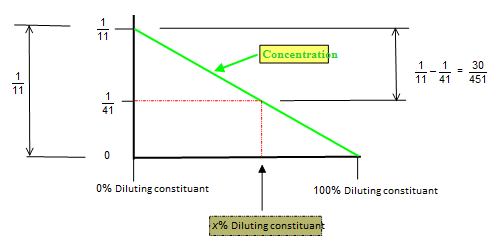color(blue)("Preamble about ratios")Preamble about ratios
Consider the ratio of 1:10.
This consists of 1 part of something added to 10 parts of something else. So the total amount of parts is 11.
Thus a 1:10 ratio is a concentration of 1/11xx100 = 9.09bar09%111×100=9.09¯¯¯¯09%
Where the bar means repeating for ever.
And 1:40 -> 1/41xx100 ~~2.439%" "→141×100≈2.439% to 3 decimal places
.~~~~~~~~~~~~~~~~~~~~~~~~~~~~~~~
color(blue)("Solving your question")Solving your question
You have a 1:101:10 that you need to change to 1:401:40
color(blue)("Condition 1")Condition 1
color(brown)("It does not matter that you have more volume/weight")It does not matter that you have more volume/weight
What ever you use to measure the 10 use to measure a further 30 giving you 1:(10+30)->1:401:(10+30)→1:40
color(blue)("Condition 2")Condition 2
color(brown)("You wish to blend the two so that have a specific volume/weight")You wish to blend the two so that have a specific volume/weight
color(brown)("Some people do not like the following method but it works very well.")Some people do not like the following method but it works very well.
I use the principle of a straight line graph to plot the change in concentration as you gradually add more and more of one of the constituent. Thus able to determine the exact blend needed.
 Tony B
Tony B
The bottom axis measures the amount of diluting constituent from none at all to nothing but the diluting constituent.
color(brown)("What follows is saying: the gradient of the little bit is the same all of it!")What follows is saying: the gradient of the little bit is the same all of it!
So we have:" "x-:30/451=100-:1/11" " x÷30451=100÷111
" "x xx451/30=100xx11/1 x×45130=100×111
" "x=(100xx11xx30)/(451) x=100×11×30451
x=73 7/41 % x=73741% diluting material (exact value)
The amount of the original; 1:10 mixture is:
100-73 7/41 = 26 34/41 %100−73741=263441% exact value
'~~~~~~~~~~~~~~~~~~~~~~~~~~~~~~~~~~
Check
26 34/41 xx1/100xx 1/11 =1/41" "color(red)("This works so ok!")263441×1100×111=141 This works so ok!
 Tony B
Tony B 
